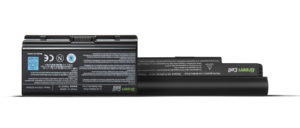Each portable device is equipped with the battery, without it the mobility advantage cannot be reached. The most common type is a Li-ion battery with durability limited to approx. 500 charging cycles which means 2-3 years depending on the usage. Cells inside the battery are getting older and the capacity gets naturally lower. The first sign of cells decrease is shortened performance time until the moment when the only way to work on your laptop is to keep it connected to the charger for the whole time. As a result its the biggest advantage has been lost. One of the most effective solutions is to replace the faulty item with the new one.
How to find the right replacement?
The most popular opinion is that to find a right replacement you have to simply know laptop’s model and its producer. It is helpful, however not the most important. It is good to know also its original parameters, voltage, and the capacity which could be found on the sticker placed on the battery’s casing.
Battery model
Laptop battery is a part of the bigger mechanism and, as each element, has its unique symbol. If you know it, you’re at 80% successful. In practice, it is difficult to find an incorrect replacement taking into consideration the battery model only. It is the first and the most important thing you should know to choose a replacement suitable for your portable computer
Voltage
Finding the right battery for your laptop based on the battery model is not the end of the process. The second feature you should also check is its voltage. Depending on the laptop’s requirements, producers equip them with 10.8 or 11.1V – they are compatible, or 14.4 or 14.8 which may also be used interchangeably. The battery’s voltage is strictly connected with the cells number inside the battery – the battery with 10.8V has 6 cells, the 14.4V battery has 8 cells.
Battery Capacity
The last parameter which should be taken into consideration is the battery’s capacity. Commonly it is described by mAh (milliampere-hour) and Wh (watt-hour). The first unit – mAh is a capacity measure for cells inside the battery. On the other hand, Wh presents real, expected battery’s performance time. If you know your laptop’s energy demand in watts, as the example: if the device needs 20W, the 48Wh battery will power the laptop for about 2,5h. The rule is simple – the higher mAh/Wh rate, the longer performance time.
Check our performance batteries Green Cell PRO and Green Cell ULTRA
